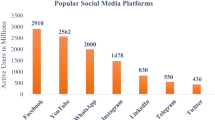Abstract
The rapid growth of social media in recent years has fed into some anti-social behavior such as kinds of cyberbullying. Previous researches only apply a single network model to complete detection. In this paper, aim to personal-bullying of Chinese social media, we propose a novel network framework with Multi Interactive-Attention and Language-environment Cognitive (MIALC) for personal-bullying detection: (1) we apply three attention features to capture multi-level and deep semantic information without using any external parsing result. Among them, the stroke attention feature can mine internal structural information of Chinese word. Meanwhile, (2) the ParagraphVector aims at extracting language-environment cognitive information from social media text, since the language-environment factors have restrictive effects on the expression of personal-bullying. The experimental results show that our proposed MIALC framework is effective.


Similar content being viewed by others
REFERENCES
Ptaszynski, M., Leliwa, G., and Piech, M., Cyberbullying Detection-Technical Report 2/2018, Department of Computer Science AGH, University of Science and Technology, arXiv preprint arXiv:1808.00926, 2018.
Sampasa Kanyinga, H., Roumeliotis, P., and Xu, H., Associations between cyberbullying and school bullying victimization and suicidal ideation, Plans Attempts Can. Schoolchild., 2014, vol. 9, no. 7. https://doi.org/10.1371/journal.pone.0102145
Cachola, I., Holgate, E., Preotiuc Pietro, D., et al., Expressively vulgar: The socio-dynamics of vulgarity and its effects on sentiment analysis in social media, Proceedings of the 27th International Conference on Computational Linguistics, 2018, pp. 2927–2938.
Cao, S., Lu, W., Zhou, J., et al., cw2vec: Learning Chinese word embeddings with stroke n-gram information, Thirty-Second AAAI Conference on Artificial Intelligence, 2018, pp. 5054–5061.
Servance, R.L., Cyberbullying, cyber-harassment, and the conflict between schools and the first amendment, Wis. Law Rev., 2003, no. 6, pp. 12–13.
Patchin, J.W. and Hinduja, S., Bullies move beyond the schoolyard: A preliminary look at cyberbullying, Youth Violence Juv. Justice, 2006, vol. 4, no. 2, pp. 148–169.
Yin, D., Xue, Z., Hong, L., et al., Detection of harassment on web 2.0, Proc. Content Anal. WEB, 2009, vol. 2, pp. 1–7.
Dinakar, K., Reichart, R., and Lieberman, H., Modeling the detection of textual cyberbullying, Fifth International AAAI Conference on Weblogs and Social Media, 2011, pp. 11–17.
Dadvar, M., Experts and machines united against cyberbullying, PhD Thesis, University of Twente, 2014.
Wulczyn, E., Thain, N., and Dixon, L., Ex machina: Personal attacks seen at scale, Proceedings of the 26th International Conference on World Wide Web. International World Wide Web Conferences Steering Committee, 2017, pp. 1391–1399.
Nikhil, N., Pahwa, R., Nirala, M.K., et al., LSTMS with attention for aggression detection, arXiv preprint arXiv:1807.06151, 2018.
Van Hee, C., Lefever, E., Verhoeven, B., Mennes, J., Desmet, B., De Pauw, G., and Hoste, V., Automatic detection and prevention of cyberbullying, International Conference on Human and Social Analytics, Proceedings, Lorenz, P. and Bourret, C., Eds., 2015, pp. 13–18.
Reynolds, K., Kontostathis, A., and Edwards, L., Using machine learning to detect cyberbullying, 2011 10th International Conference on Machine Learning and Applications and Workshops. IEEE, 2011, vol. 2, pp. 241–244.
Van Hee, C., Lefever, E., Verhoeven, B., Mennes, J., Desmet, B., De Pauw, G., and Hoste, V., Detection and fine-grained classification of cyberbullying events, Proceedings of Recent Advances in Natural Language Processing, Angelova, G., Bontcheva, K., and Mitkov, R., Eds., 2015, pp. 672–680.
Nahar, V., Al-Maskari, S., Li, X., et al., Semi-supervised learning for cyberbullying detection in social networks, Australasian Database Conference, Cham, 2014, pp. 160–171.
Al Garadi, M.A., Varathan, K.D., and Ravana, S.D., Cybercrime detection in online communications: The experimental case of cyberbullying detection in the Twitter network, Comput. Hum. Behav., 2016, vol. 63, pp. 433–443.
Badjatiya, P., Gupta, S., Gupta, M., et al., Deep learning for hate speech detection in tweets, Proceedings of the 26th International Conference on World Wide Web Companion. International World Wide Web Conferences Steering Committee, 2017, pp. 759–760.
Van Hee, C., Jacobs, G., Emmery, C., et al., Automatic detection of cyberbullying in social media text, PLoS ONE, 2018, vol. 13, no. 10.
Agrawal, S. and Awekar, A., Deep learning for detecting cyberbullying across multiple social media platforms, European Conference on Information Retrieval, Cham, 2018, pp. 141–153.
Guo, F., He, R., Jin, D., et al., Implicit discourse relation recognition using neural tensor network with interactive attention and sparse learning, Proceedings of the 27th International Conference on Computational Linguistics, 2018, pp. 547–558.
Chen, H., Liang, J., and Liu, H., How does word length evolve in written Chinese?, PloS ONE, 2015, vol. 10, no. 9.
Mikolov, T., Sutskever, I., Chen, K., et al., Distributed representations of words and phrases and their compositionality, Advances in Neural Information Processing Systems, 2013, pp. 3111–3119.
Cheng, N., Chandramouli, R., and Subbalakshmi, K.P., Author gender identification from text, Digital Invest., 2011, vol. 8, no. 1, pp. 78–88.
Le, Q. and Mikolov, T., Distributed representations of sentences and documents, International Conference on Machine Learning, 2014, pp. 1188–1196.
Mikolov, T., Chen, K., Corrado, G., and Dean, J., Efficient estimation of word representations in vector space, arXiv preprint arXiv:1301.3781, 2013.
Funding
This work was supported by The National Natural Science Foundation of China (nos. 61962057, 61563051, 61662074, 61262064). The Key Project of National Natural Science Foundation of China (61331011). Xinjiang Uygur Autonomous Region Scientific and Technological Personnel Training Project (QN2016YX0051). Xinjiang Tianshan Youth Project (2017Q011).
Author information
Authors and Affiliations
Corresponding author
Ethics declarations
The authors declare that they have no conflicts of interest.
About this article
Cite this article
Niu, M., Yu, L., Tian, S. et al. Personal-Bullying Detection Based on Multi-Attention and Cognitive Feature. Aut. Control Comp. Sci. 54, 52–61 (2020). https://doi.org/10.3103/S0146411620010083
Received:
Revised:
Accepted:
Published:
Issue Date:
DOI: https://doi.org/10.3103/S0146411620010083




